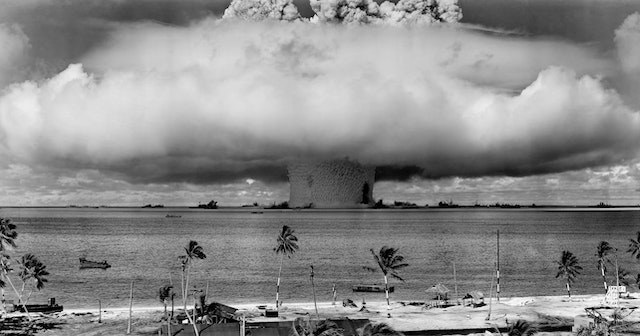
Why was the Manhattan Project called the Manhattan Project? It was named after the city where its headquarters were originally located.
The concept for the Manhattan Project began when Otto Hahn and Fritz Strassmann worked out how to make nuclear fission happen in 1938. Fermi had managed to make it happen in 1934, but he hadn’t known what he had done. They were carrying out experiments where they bombarded elements with neutrons and they discovered that when they bombarded uranium nuclei, they broke into two halves. However, these two halves were slightly lighter than the original uranium nucleus. Mass is energy and this difference in mass had been released as energy. This is nuclear fission. They also realized that the process released neutrons, which could hit other nuclei and keep the process going, which is a chain reaction. Although, the first successful chain reaction wasn’t performed until December 2, 1942.
It took a surprisingly long time for the Manhattan Project to get off the ground. With hindsight, we can see how powerful and dangerous nuclear bombs can be, but, at the time, the people in power didn’t really understand the protestations of the scientists who were saying that America needed to create a bomb before Germany or Japan could. Many of the scientists that were involved in the early days of the project and who were trying to pressure the American government into researching nuclear fission were Germans and Austrians who had fled the Nazis. President Roosevelt was nudged into action when Albert Einstein put his signature and lent his name to a letter explaining the dangers of nuclear fission. Einstein was a pacifist and later said that he regretted putting his name on the letter. Even Britain was more advanced in nuclear fission research at the start of the war than America was. However, when Japan bombed Pearl Harbor in 1941, America was drawn into the war and they threw their financial might behind atomic research.
The Manhattan Project had its start in the middle of 1941 as the Office of Scientific Research and Development. The army was put in charge of research and development on the project. In 1942, Colonel James C Marshall, an army engineer, was put in charge of the project. His first task was to organize a headquarters and then start construction of the facilities required for the project. At that time, no one knew exactly what would be required and it ended up needing many more buildings and costing a lot more money than anyone could have expected. Marshall started by locating his headquarters and he put it at 270 Broadway, New York. He chose that location because it was close to the Corps of Engineers’ North Atlantic Division, Stone & Webster, the contractors, and Colombia University where a lot of the research was being done. The project was called the “Laboratory for the Development of Suitable Materials”. Not a very catchy name.
So, why did it become the Manhattan Project? When Colonel Marshall started the project and located his headquarters, he created an Army Corps of Engineers district. When the Engineer Corps has work to do or things to build, they organize themselves into districts. Each district has a geographical boundary and they take care of all the work within that district. Colonel Marshall created the Manhattan District, or the Manhattan Engineering District for the project. However, it didn’t have a geographical boundary. He made the district because he thought it would stop suspicion. A lot of engineers and scientists would be working in the area. It would look a lot less suspect if they were working within an engineering district and the Manhattan Engineering District would cover all of the work done in and around New York. Over the next few months, people started to use the single word “Manhattan” to refer to the project and it stuck. It was used on paperwork and became the name for the project.
Secrecy was a huge part of the project. Over 600,000 people worked on the Manhattan Project throughout its life, with a peak of 130,000 people at a single time. That was a huge amount of people, but none of them could know what they were doing. In the end, probably only a very few people actually knew what the goal of the Manhattan Project was. When FDR died and President Truman replaced him, he had to be briefed on the Manhattan Project because it was so secret he had never heard of it. That being said, the Soviet Union did have at least two spies in the Manhattan Project. One was Klaus Fuchs, one of the main scientists involved in the project. It is unknown how much his information helped the Soviet Union make their own bomb, but it was certainly significant. And this is what I learned today.
Photo by Pixabay: https://www.pexels.com/photo/grayscale-photo-of-explosion-on-the-beach-73909/
Sources
https://en.wikipedia.org/wiki/Klaus_Fuchs
https://www.osti.gov/opennet/manhattan-project-history/Events/1945-present/med_45-46.htm
https://en.wikipedia.org/wiki/Einstein%E2%80%93Szilard_letter
https://www.energy.gov/lm/manhattan-project-background-information-and-preservation-work
https://www.osti.gov/opennet/manhattan-project-history/Events/events.htm
https://www.osti.gov/opennet/manhattan-project-history/Events/1890s-1939/discovery_fission.htm
https://www.ushistory.org/us/51f.asp
